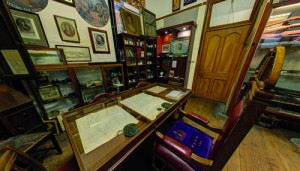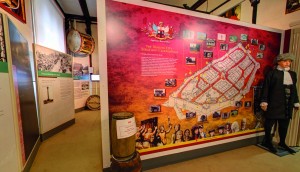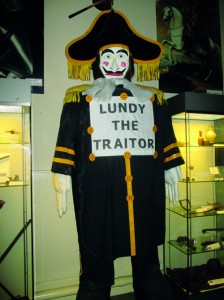APPRENTICE BOYS [OF DERRY] MUSEUM
Published in Issue 3 (May/June 2014), Reviews, Volume 22I have to admit that I felt apprehensive about visiting this museum. It was a bit like entering the lion’s den to go into the headquarters of one of the loyal orders. The big friendly posters outside did not help and the welcome from the porter was not exactly warm, although that may have been because he was embarrassed to ask me for my £2 entrance fee.
The building itself is an impressive neo-Gothic Victorian structure beside a section of the famous city wall that overlooks the Bogside with its ‘Free Derry’ mural. The main exhibition is upstairs and is dedicated to the heroes of the famous siege of 1689—the Williamite heroes, that is. The order was founded in memory of the thirteen apprentices who slammed the city gates shut in the face of James II, sparking off the siege by his army and the war in Ireland. For almost 300 years the Boys have celebrated that event, which, not surprisingly, is the main purpose of the museum.

Some of the artefacts on display associated with the history of the clubs.
(Apprentice Boys Museum)
You climb stairs decorated with regalia of the association and maps showing its international connections. The way into the exhibition room is dominated by a large map of the city with the siege heroes’ trail marked on it (a more manageable brochure is also available) and an equally large model of Derry during the siege. By pressing buttons you can light up specific sites, such as the famous gates or the double bastion where ‘Roaring Meg’, the large cannon, was situated.
Much of the space is taken up with models, life-size manikins and information panels. These portray the main individuals associated with the siege (such as Governor Walker), show the progress of events and provide a historical narrative. The visitor is invited to go to the audio-visual area to watch four introductory films. The first is about the siege itself: the run-up to it, its course and the immediate aftermath. The other three have the general heading of ‘the wider history of Derry’ but in fact are devoted to the history of the Apprentice Boys, and what is said or shown in one is often repeated in the others. Interestingly, the official name of the order is the ‘Apprentice Boys of Derry’ and the historical documents on display illustrate that for centuries the shorter form of the name was the norm.

The way into the exhibition room is dominated by a large map of the city with the siege heroes’ trail marked on it. (Apprentice Boys Museum)
Once the films are over you are free to look around. There are a few original artefacts from the siege
period, such as pistols, swords and cannon-balls. Other original objects include a fine collection of china, featuring a Williamite tea service and other such items commemorating various British monarchs over the decades. Models of the Walker monument that once stood on the city’s walls (before being blown up by the IRA) abound, and there are also examples of drums used by Loyalist bands, although not the (in)famous Lambeg. Look out for the reproduction of the poster setting the price for dogs, rats and horses that the besieged populace were forced to turn to for food as the weeks dragged on.

The most imposing exhibit is the effigy of Governor Lundy. (Apprentice Boys Museum)
The most imposing artefact is the tall effigy of Governor Lundy. One of these is the centrepiece of the annual Maiden City Festival (as the siege commemorations have been rebranded), when it is set alight at the climax to the day’s events. Elsewhere an information panel explains why he is known as a traitor. Appointed governor by James II, he continued to recognise him as king and would have allowed his garrison (and the king himself) into the city had not the civic leaders intervened. His treachery therefore was to the city and the Protestant cause. Other panels also explain the battle cry of ‘No surrender’, which greeted James II’s attempt to enter the city, and the crimson flag that was erected to express defiance against the besiegers. The legend is that the original flag was dyed red by the blood of the city’s defenders.
Next you can visit the various meeting rooms downstairs. The main one, decorated with masonic-like trappings, is where a new member is sworn into the order. The Apprentice Boys actually consists of a number of clubs, eight ‘parents’ in the city with branches elsewhere. Photographs of past dignitaries hang on the panelled walls against which are the governing body’s seats, while there is an imposing throne-like chair and gavel for the president. Exhibits devoted to the history of the order itself are on display in another room, featuring banners, photographs and so on.
If you are in Derry I would advise visiting the Apprentice Boys’ museum. It is on a par with many similar local or institutional museums throughout Ireland in making the best use of its resources and it certainly displays an enthusiasm for its subject. After all, the siege was an event of European significance and the museum gives an insight into its place in Ulster loyalist culture. The exhibition is unashamedly one-sided in its interpretation of history and not everyone will be comfortable with the Apprentice Boys’ view of the past. I found it somewhat like stepping through the looking-glass into a version of Ireland in which the Protestants only suffered and were never the Ascendancy. It should be pointed out that other museums of Derry’s history are also available.
Tony Canavan is the editor of Books Ireland.
















